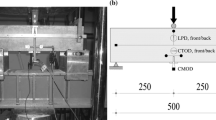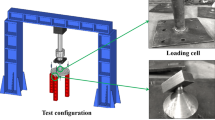Abstract
This paper presents the results of a study of steel-fiber-reinforced concrete (SFRC) in flexural fatigue. An experimental technique was developed to determine the moment at which cracking is initiated, thus allowing a quantification of the survival life beyond cracking. Basically, the experimental program consisted of 8 series of flexural fatigue tests (under third-point loading) performed at three different levels of stress (70%, 75% and 85% of first-crack strength). Six SFRC mixtures (at a fiber dosage of 40 kg/m3) were prepared and tested. The variables were the water/cement ratio (0.45 and 0.35), and the fiber geometry (hooked, anchored, and crimped fibers). Two similar plain concretes (w/c=0.45 and 0.35) were used as reference mixtures. The fatigue response of the SFRC mixtures was found to be quite variable, both before and after cracking. The survival life appeared to be significant, especially at the lower level of stress investigated, but the overall variability prevented the identification of specific trends concerning the influence of the water/cement ratio and the type of fibers. The variability of the number of fibers found in the bottom half of the specimens at the critical section could not explain the variability of the survival life. It was concluded that the orientation of the fibers also had an influence in this respect, and that a fiber content higher than that utilized, or the use of larger test specimens, was probably required to limit this variability.
Résumé
Cet article présente les résultats d'une étude du comportement de bétons renforcés de fibres d'acier (BRFA) sous sollicitation cyclique avant et après fissuration. Une technique expérimentale permettant de déterminer le moment où la fissuration est initiée a été mise au point afin de quantifier la survie post-fissuration, c'est-à-dire le nombre de cycles survenus après l'initiation de la fissuration. Huit séries d'essais de flexion cyclique (essais 3 points) ont été réalisées à différents niveaux de contrainte (70%, 75% et 85% de la limite de rupture). Six formulations de BRFA comportant 40 kg/m3 de fibres ont été mises au point et testées, les variables de composition étant le rapport eau/ciment (0,35 et 0,45) et la géométrie des fibres (crochetées, ancrées et ondulées). Deux bétons témoins non renforcés de composition similaire (e/c=0,35 et 0,45) ont aussi été testés. Les résultats des essais de fatigue effectués sur les BRFA démontrent une dispersion relativement importante, avant fissuration comme après. La survie post-fissuration apparaît significative, en particulier dans le cas du niveau de contrainte le moins élevé, mais la dispersion observée ne permet pas l'identification de tendances claires quant à l'influence du rapport eau/ciment et du type de fibres. La variabilité du nombre de fibres sous l'axe neutre à la section de rupture des corps d'épreuve ne peut expliquer la variabilité de la survie post-fissuration. Il semble donc que l'orientation des fibres joue probablement aussi un rôle important. Il est également probable qu'un dosage de fibres plus élevé que celui qui a été utilisé, ou l'utilisation d'éprouvettes de plus grandes dimensions, permettrait de réduire la variabilité de la survie post-fissuration de façon significative.
Similar content being viewed by others
References
Bissonnette, B. and Pigeon, M., ‘Tensile creep at early ages of ordinary, silica fume and fibre reinforced concretes’,Cement and Concrete Research 25 (3) (1995) 1075–1085.
Granju, J.-L. ‘Rechargements minces adhérents de dalles, dallages ou chaussées en béton: fibrage et limitation du décollement de la couche de rechargement’, in ‘Colloque Francophone sur les Bétons Renforcés de Fibres Métalliques: Recherches en Cours et Réflexions sur leur Dévelopment’, Proceedings of an International Conference, Béthune (France), July 4–5 1994, (1994) 105–113.
Ramakrishnan, V. and Lokvik, B. J., ‘Fatigue strength and endurance limir of plain and fibre reinforced concretes—A critical review’, in ‘Fatigue and Fracture in Steel and Concrete Structures’, ISSF '91 Proceedings, Vol. 1, December 19–21 1991, (1991) 381–405.
Yin, W. S. and Hsu, T. T. C., ‘Uni- and bi-axial compressive fatigue of fibre concrete’ in ‘Serviceability and Durability of Construction Materials’, Proceedings of the First Materials Engineering Congress (ASCE), Vol. 1, August 13–15 1990, (1990) 1172–1181.
Saito, M., ‘Characteristics of microcracking in concrete under static and repeated tensile loading’,Cement and Concrete Research 17 (1987) 211–218.
Johnston, C. D. and Zemp, R. W., ‘Flexural fatigue performance of steel fibre reinforced concrete-Influence of fibre content, aspect ratio and type’,ACI Materials Journal 88 (4) (1991) 374–383.
Morgan, D. R., Mindess, S. and Chen, L., ‘Testing and specifying toughness for fibre reinforced concrete and shotcrete’, in ‘Fibre Reinforced Concrete, Modern Developments’, Proceedings of a Workshop, Toronto, March 1995 (N. Banthia and S. Mindess editors, 1995).
Oh, B. H., ‘Fatigue-life distributions of concrete for various stress levels’,ACI Materials Journal 88 (2) (1991) 123–128.
Ramakrishnan, V., Oberling, G. and Tatnall, P., ‘Flexural fatigue strength of steel fibre reinforced concrete’, ACI SP-105 (American Concrete Institute, Detroit) 225–245.
Attar, A. and Mesureur, B., ‘Étude des poutres fléchies en béton renforcé de fibres métalliques: du matériau à la structure’, in ‘2e Colloque Francophone sur les Bétons Renforcés de Fibres Métalliques’, Proceedings of an International Conference, Toulouse (France), July 4–5 1996, (1996) 21–30.
Saucier, F., Mailhot, T. and Pigeon, M., ‘Réflexion sur la capacité de survie après fissuration du béton armé de fibres soumis à une sollicitation de fatigue en flexion’, in ‘2e Colloque Francophone sur les Bétons Renforcés de Fibres Métalliques’, Proceedings of an International Conference, Toulouse (France), July 4–5 1996, 97–106 (1996).
Author information
Authors and Affiliations
Additional information
Editorial Note Laval University (Canada) is a RILEM Titular Member. Prof. M. Pigeon is a RILEM Staff Member. He participates in the work of RILEM TCs 181-EAS (Early age shrinkage induced stresses and cracking in cementitious systems) and is also the Secretary of RILEM TC FHP (Predicting the frost resistance of high performance concrete exposed to numerous freezing and thawing cycles). Dr. B. Bissonnette is a member of RILEM TC 181-EAS.
Rights and permissions
About this article
Cite this article
Mailhot, T., Bissonnette, B., Saucier, F. et al. Flexural fatigue behavior of steel fibre reinforced concrete before and after cracking. Mat. Struct. 34, 351–359 (2001). https://doi.org/10.1007/BF02486486
Received:
Accepted:
Issue Date:
DOI: https://doi.org/10.1007/BF02486486




